Abnormally dry to severe drought conditions continue to prevail across the islands. Eight consecutive weeks of severe drought conditions in the U.S. Virgin Islands for St. John and St. Thomas will trigger the USDA Farm Service Agency Livestock Forage Disaster Program and a USDA Secretarial Drought Declaration. Isolated areas of beneficial rains have occurred in the Luquillo Mountains and across western Puerto Rico. However, extended forecasts call for near normal to below normal rainfall to be more likely than not through July.
View this update in Spanish.
Key Points
- Puerto Rico Conditions: Beneficial rains have been observed across the western third of Puerto Rico with some drought improvement noticed. Nevertheless, Abnormally Dry (D0) to Moderate Drought (D1) conditions continue to prevail across much of central and eastern portions of the island.
- U.S. Virgin Islands Conditions: Severe Drought conditions (D2) continue to prevail across Saint Thomas, Saint John, and Saint Croix. Limited rainfall activity has been observed across the local islands. A USDA Secretarial Drought Disaster Declaration was triggered for St. John and St. Thomas on May 6, 2021.
- Puerto Rico Impacts: Voluntary water-use restrictions have been requested with some water restrictions imposed in some areas. There has been some impact to crops and pastures.
- U.S. Virgin Islands Impacts: There are signs of soil cracking on St. Thomas and St. Croix, and vegetation is showing distress across all the islands. Precautions such as ordering hay and water deliveries are being taken to get through the dry season. The next three weeks will be critical to the agriculture sector.
- Looking Ahead: Long range models show the most likely outcome is that rainfall into July will be in the normal to below-normal category. Hence, the persistence and/or expansion of drought will remain the most likely outcome in drought conditions into July.
- For weather information specific to your area, please monitor products issued by the National Weather Service in San Juan, Puerto Rico.
Current U.S. Drought Monitor map for Puerto Rico with data valid for May 4, 2021. The U.S. Drought Monitor is updated each Thursday to show the location and intensity of drought across the country.
Nearly 62% of Puerto Rico is classified by the U.S. Drought Monitor as being Abnormally Dry (D0), while 17% of the island is classified as Moderate Drought (D1).
Current U.S. Drought Monitor map for the U.S. Virgin Islands with data valid for May 4, 2021. The U.S. Drought Monitor (USDM) is updated each Thursday to show the location and intensity of drought across the country.
Saint Thomas, Saint John, and Saint Croix continue under Severe Drought conditions (D2).
U.S. Drought Monitor Categories
U.S. Drought Monitor Categories
Current U.S. Drought Monitor map for Puerto Rico with data valid for May 4, 2021. The U.S. Drought Monitor is updated each Thursday to show the location and intensity of drought across the country.
Nearly 62% of Puerto Rico is classified by the U.S. Drought Monitor as being Abnormally Dry (D0), while 17% of the island is classified as Moderate Drought (D1).
Current U.S. Drought Monitor map for the U.S. Virgin Islands with data valid for May 4, 2021. The U.S. Drought Monitor (USDM) is updated each Thursday to show the location and intensity of drought across the country.
Saint Thomas, Saint John, and Saint Croix continue under Severe Drought conditions (D2).
Current Conditions
Rainfall Deficits
- Puerto Rico: Year to date rainfall deficits of 4 to 7 inches are widespread across Puerto Rico. For example, through May 3, 9.61 inches of rain have fallen in San Juan, about 4.5 inches less than the normal of 14.15 inches. This is the 24th driest year to date in 122 years of data. Basically a 1 in 5 year dryness. At Ensenada, in the Ponce Municipality, only 3.83 inches of rain have been observed this year, about 55% of normal, and the driest such period since 2001. Deficits during the last 3 month range from 2 to 4 inches across north central and eastern interior Puerto Rico.
- U.S. Virgin Islands: The year to date rainfall deficits generally range from 3 to 6 inches across the U.S. Virgin Islands. Cyril King AP at Charlotte Amalie has a deficit of nearly 4 inches, and has seen only 60% of normal rainfall through May 3. This is the driest such period since 2000. Similarly, Rohlsen Airport on St. Croix has seen about 60% of normal rainfall, with 4.65 inches.
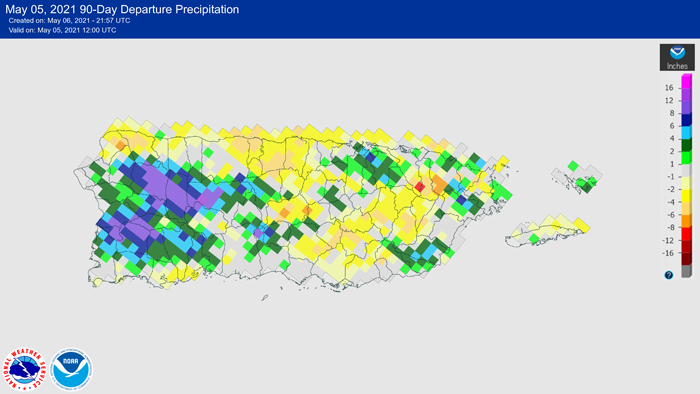
Soil Moisture Conditions in Puerto Rico
Based on data retrieved from the Puerto Rico Agricultural Water Management (PRAGWATER), low soil moisture is observed across the majority of Puerto Rico, except across areas of eastern Puerto Rico and the western interior of the island. This soil moisture distribution across the island is consistent with the rainfall pattern observed.
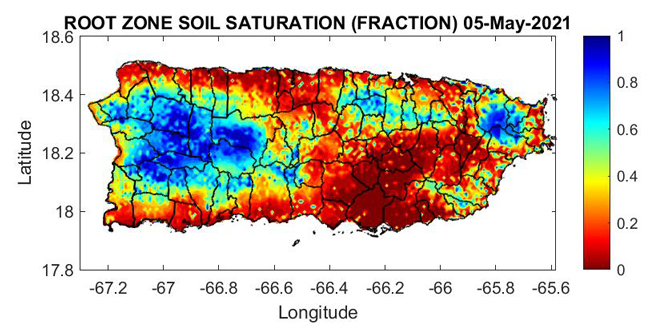
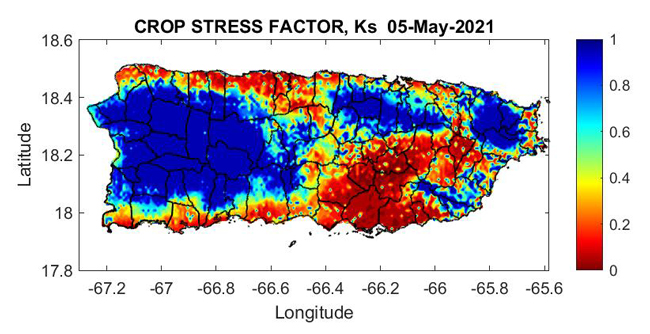
Streamflow Conditions in Puerto Rico
The 28-day average streamflow measured by the U.S. Geological Survey (USGS) gaging network shows most locations across south, central, and eastern Puerto Rico running in the 10th to 24th percentiles, which is below the normal range. Elsewhere across Puerto Rico, streamflows are running near the normal range. Based on data provided by the Water Authority, there are three reservoirs under observation: Lago Toa Vaca, Lago Carite, and Lago Guajataca.
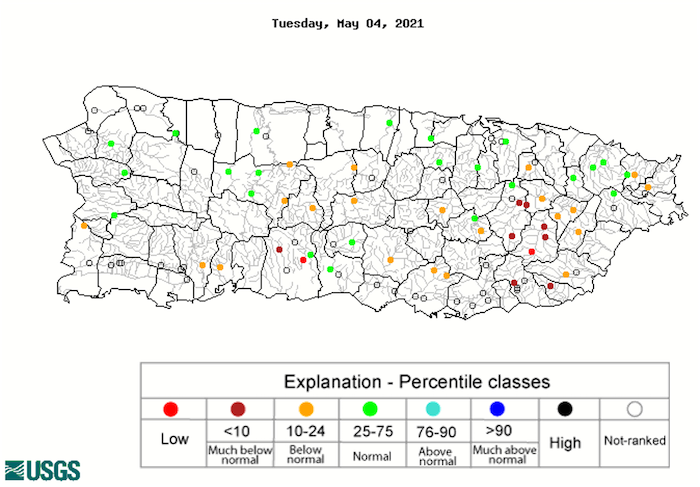
Groundwater Conditions
The groundwater level retrieved from the U.S. Geological Survey network indicated most of the wells at normal levels except for a few outliers across south and north central Puerto Rico.
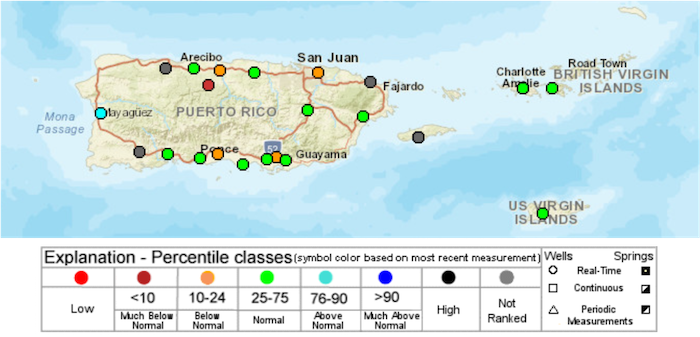
Outlooks and Impacts
Rainfall Outlook
Based on the 3-month extended forecast by the Caribbean Climate Outlook Forum (CariCOF), as well as the U.S. National Weather Service National MultiModel Ensemble (NMME), there is a higher chance to observe below-normal rainfall through at least June or July 2021. Nevertheless, there is a higher chance to observe near- to above-normal rainfall during Fall 2021. Unfortunately, drought impacts should continue to worsen through mid-summer.
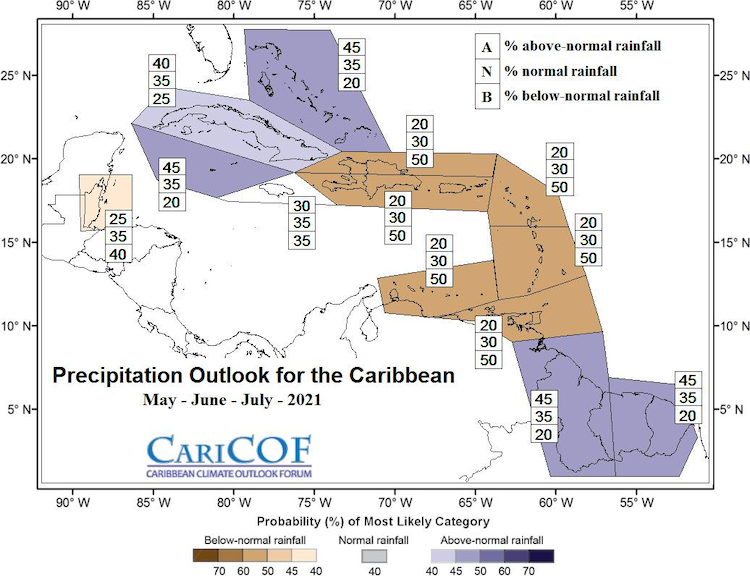
Sector Impacts
General Conditions
- Puerto Rico. Since the beginning of the year, high temperatures and scarce rain have affected the southwestern region of Puerto Rico, where a significant amount of agricultural activity is located. An Extension agent in the area reports seeing long periods of little rain and high temperatures with short bursts of intense rainfall.
- U.S. Virgin Islands. Soil cracking began earlier this year as farmers reported that the first signs of cracking developed in late March 2021 on St. Thomas. Scattered rainfall territory-wide is occurring but not soaking into the soil. Farmers are also reporting that it is hotter and soil conditions are much drier than at this time in previous years. The Virgin Islands Department of Agriculture (VIDA) is reporting that farmers began planning mitigation tools earlier in the year and are also seeking chop to feed livestock. VIDA also indicated that they will be ordering hay from the states and shipping it in to ensure livestock farmers have enough to get through the dry season. Finally, VIDA reported that on St. Croix, water deliveries to the agricultural community included more than 1,051,410 gallons of water in March, and in April water deliveries were listed as 952,353 gallons.
- St. John and St. Thomas have reached the criterion of 8 consecutive weeks at D2 (Severe Drought) needed for a USDA Secretarial Drought Disaster Declaration. This also triggers the Livestock Forage Disaster Program, administered by USDA’s Farm Service Agency.
Forest and Fire Conditions
- Region-wide. With dry conditions across the Virgin Islands and much of Puerto Rico, forests and grasslands are at risk for fire. The San Juan National Weather Service Fire Forecast reports elevated fire danger potential across the southern plains of Puerto Rico. Typically lower relative humidity values between mid-morning and afternoon, when combined with wind gusts, elevate the risk of fires at those times.
Specialty and Row Crops
- Puerto Rico.
- A farmer in Santa Isabel reported that their crops and operations are currently affected by drought. They have restricted water use on their farm due to low water levels in the AEE irrigation canal they rely on.
- Honey availability has decreased in the southwestern region. Due to a reduction in nectar flow, bees are producing less honey. High temperatures are causing heat stress in bees, requiring them to use more energy to regulate hive temperature. As a result, beekeepers in southwest Puerto Rico are providing water and supplements to hives.
- St. Croix, USVI. Poultry farmers without access to water are using cisterns and are reporting a decrease in egg production due to heat.
- St. John, USVI. Farmers are reporting that rain is scant and that they are working to use wells and groundwater when available. Most have irrigation set up so that they can water early and late in the day to combat drought conditions. Farmers are reporting that it is hotter and drier than usual, and that a lack of rain and early warm weather are indicators of an early onset of drought conditions. These observations led them to plan for a much drier, warmer spring season.
- St. Thomas, USVI. A few specialty and row crop farmers are using irrigation methods, and many are purchasing water, which is affecting overall production. Most expressed that the cost of feed and water are increasing.
Fruit Trees
- Puerto Rico. A farmer reported that due to lack of rain the last two months in the central southern region, crops are stressed (particularly avocado trees). They are irrigating longer to compensate for the lack of rain.
Dairy, Livestock, and Pasture
- St. Croix, USVI. Livestock farmers on St. Croix are seeking to purchase feed since chop is not available, and many are seeking cut and carry to offset feed in an effort to delay the need to purchase hay. Many also reported that, while some rain fell, due to the warmer than average temperatures and high winds, evaporation and a lack of soil moisture is making it harder for farmers who do not have irrigation lines in place. Most believe that the soil is not soaking up the water as well as under normal conditions, and that high temperatures are impacting crops and livestock during these severe drought conditions.
- St. Thomas. Poultry farmers have little to no access to fresh grass, which is brown and very dry due to water scarcity.
For More Information
- National Weather Service (NWS) Weather Forecast Office - San Juan: Climate and Drought Information
- NWS Drought Information Statements for Puerto Rico and the U.S. Caribbean
- Drought.gov:
- Caribbean Drought Bulletins. Caribbean Regional Climate Center, Caribbean Institute for Meteorology and Hydrology (CIMH), Barbados
- U.S. Department of Agriculture (USDA) Caribbean Climate Hub drought and disaster assistance resources for tropical forestry and agriculture
Prepared By
Odalys Martinez
Senior Service Hydrologist, NWS Weather Forecast Office San Juan
Meredith Muth
NOAA/National Integrated Drought Information System (NIDIS)
William Gould, Nora Alvarez, and Eva Holupchinski
USDA Caribbean Climate Hub, USFS International Institute of Tropical Forestry
Christina Chanes, Gregory Guannel
University of the Virgin Islands
Victor Murphy
Climate Services Program Manager, National Weather Service Southern Region
Thanks to the Agricultural Extension Service, College of Agricultural Sciences, University of Puerto Rico-Mayagez (UPR). Thank you to Duamed Colón-Carrión, President & CEO of Agro Tropical, Inc.; Betzaida Ortíz, Finca Atabey, Agro.; Alberto J. Maldonado Rodríguez, Agricultural Extension Service Mayagüez; Gabriela Saadé Yordán; and Eric Harmsen, Professor of Agricultural Engineering UPR.
USVI Reporting Input: Several individuals contributed to this report and we are acknowledging the following for their support including the faculty, staff, and collaborators of the UVI School of Agriculture, Cooperative Extension, UVI Physics Program, UVI Etelman Observatory, UVI Agricultural Experiment Station, VI Department of Agriculture, UVI Caribbean Green Technology Center, as well as the USDA Office of the Chief Economist, National Parks Service in St. Croix, USDA Farm Service Agency, Coral Bay Community Council, and the many volunteers, drought reporters, and farmers from across the territory.
About This Report
This drought update is issued in partnership between the National Integrated Drought Information System (NIDIS), the National Oceanic and Atmospheric Administration (NOAA) National Weather Service, the U.S. Department of Agriculture (USDA), and the University of the Virgin Islands. The purpose of the update is to communicate a potential area of concern for drought expansion and/or development within Puerto Rico and the U.S. Virgin Islands based on recent conditions and the upcoming three-month forecast.
NIDIS and its partners will issue these updates every two months. Subscribe for these U.S. Caribbean drought updates here.





